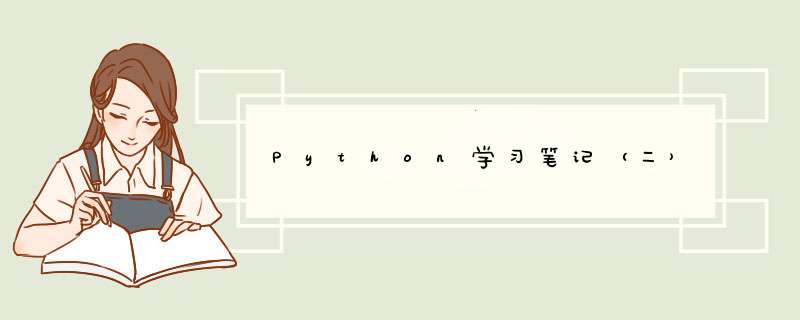
- 条件语句
- if语句
- if - else 语句
- if-elif-else语句
- for语句
- for-else语句
- while语句
- while-else语句
if函数用于有条件的执行:
if 2>1:
print("hello world")
else:
print("Hello World")
#最后输出的结果为hello world
上面是一个最简单的例子,举个稍微复杂点的看看
x = int(input("Please enter an integer:"))
if x < 0 :
x = 0
print('变量赋值变成了0')
elif x == 0:
print('Zero')
elif x == 1:
print('Single')
else:
print('More')
好啦,言归正传,我们来介绍一下if的语法格式吧。
if语句包含零个和多个elif子句,也可以选择使用else子句。也就是说用if语句的话if肯定要有。elif可以选择有,使用的话可以同时使用多个,else可以选择使用,使用的话最多只能用一个。
(elif其实就等于C语言和Java里面的else if)
if expression: expr_true_suite
- if语句的expr_true_suite代码块如果要执行的话,必须是expression为true的时候才会执行,也就是它为真的时候才会执行。否则就会跳过这一块代码块,继续执行紧跟在后面的代码块。
- 单个if上的expression可以通过布尔 *** 作符and,or和not实现多重条件判读
【例】
if 2 > 1 and not 2 > 3:
print('Correct Judgement!')
注:这个例子就是同时判断2>1和2>3这两个语句,只要两个结果都是true的时候才会执行下面的print!!
if - else 语句if expression: expr_true_suite else: expr_false_suite
- python提供了于if搭配使用的else,结合上面的if讲,如果if上的expression是false,那么就执行else里面的语句;反正,运行if代码块就会跳过else!
【例】来个小小的实践
temp = input("猜一猜霜鱼在想什么数字呢??")
guess = int(temp) #input函数接收的任何数据类型都默认是str!!这个要重点注意,在后面的数据类型转换很重要!!
if guess == 666:
print("可以可以,你猜对了!哈哈哈哈")
else:
print("不行,你不懂我!QAQ")
print("嘿嘿,只有一次机会哦,拜拜!!")
if是可以嵌套使用的,也就是一个if语句中是可以嵌入另一个if语句的,这样就会有一个不一样的效果,构成不同层次的选择结构。
Python使用缩进表示代码块边界哦,不是用{}哦!!这个要和C和Java区分好,同时也要注意else的悬挂问题。如果缩进了报错,会默认嵌入在if里的else!!
if-elif-else语句先给个例子看看:
if expression1: expr1_true_suite elif expression2: expr2_true_suite . . elif expressionN: exprN_true_suite else: expr_false_suite
注:elif语句即为 else if,用来检查多个表达式是否为真,并在为真时执行特定代码块中的代码。
【例】
temp = input('请输入成绩:')
source = int(temp)
if 100 >= source >= 90:
print('A')
elif 90 > source >= 80:
print('B')
elif 80 > source >= 60:
print('C')
elif 60 > source >= 0:
print('D')
else:
print('输入错误!')
for语句
for循环时迭代循环,在Python中相当于一个通用的序列迭代器,可以遍历任何有序序列,如str、list、tuple等,也可以遍历任何可迭代对象,如dict.
【例】for的使用语法
for 迭代变量 in 可迭代对象: 代码块
注:每次循环,迭代变量被设置为可迭代对象的当前元素,提供给代码块使用。
【例子】
for i in 'ILoveLSGO':
print(i, end=' ') # 不换行输出
# I L o v e L S G O
member = ['张三', '李四', '刘德华', '刘六', '周润发']
for each in member:
print(each)
# 张三
# 李四
# 刘德华
# 刘六
# 周润发
dic = {'a': 1, 'b': 2, 'c': 3, 'd': 4}
for key, value in dic.items():
print(key, value, sep=':', end=' ')
# a:1 b:2 c:3 d:4
dic = {'a': 1, 'b': 2, 'c': 3, 'd': 4}
for value in dic.values():
print(value, end=' ')
# 1 2 3 4
for-else语句
【语法】
for 迭代变量 in 可迭代对象: 代码块 else: 代码块
当 for循环正常执行完的情况下,执行 else输出,如果 for循环中执行了跳出循环的语句,比如 break,将不执
行 else代码块的内容,与 while - else语句一样。
【例】
for num in range(10, 20): # 迭代 10 到 20 之间的数字
for i in range(2, num): # 根据因子迭代
if num % i == 0: # 确定第一个因子
j = num / i # 计算第二个因子
print('%d 等于 %d * %d' % (num, i, j))
break # 跳出当前循环
else: # 循环的 else 部分
print(num, '是一个质数')
# 10 等于 2 * 5
# 11 是一个质数
# 12 等于 2 * 6
# 13 是一个质数
# 14 等于 2 * 7
# 15 等于 3 * 5
# 16 等于 2 * 8
# 17 是一个质数
# 18 等于 2 * 9
# 19 是一个质数
while语句
while语句最基本的形式包括一个位于顶部的布尔表达式,一个或者多个属于while代码块的缩进语句。
while 布尔表达式: 代码块
注:while循环的代码块会一直执行。直到布尔表达式为false为止就会跳出while。
如果布尔表达式里面不是<、>、==、!=、in、not in等这些运算符,而是给出了一个具体的数值之类的也是可以的。
和上一期一样,0表示false,1表示true。也可以写入str和list或者任何序列,长度非零视为真,执行循环体;否则为假,不执行循环体。
【例】
count = 0
while count < 3:
temp = input("不妨猜一下小哥哥现在心里想的是那个数字:")
guess = int(temp)
if guess > 8:
print("大了,大了")
else:
if guess == 8:
print("你是小哥哥心里的蛔虫吗?")
print("哼,猜对也没有奖励!")
count = 3
else:
print("小了,小了")
count = count + 1
print("游戏结束,不玩儿啦!")
【例】布尔表达式返回0,循环终止。
string = 'abcd' while string: print(string) string = string[1:] # abcd # bcd # cd # dwhile-else语句
【语法】
while 布尔表达式: 代码块 else: 代码块
当 while循环正常执行完的情况下,执行 else输出,如果 while循环中执行了跳出循环的语句,比如 break,将不执行 else代码块的内容。
【例】
count = 0
while count < 5:
print("%d is less than 5" % count)
count = count + 1
else:
print("%d is not less than 5" % count)
# 0 is less than 5
# 1 is less than 5
# 2 is less than 5
# 3 is less than 5
# 4 is less than 5
# 5 is not less than 5
count = 0
while count < 5:
print("%d is less than 5" % count)
count = 6
break
else:
print("%d is not less than 5" % count)
# 0 is less than 5
欢迎分享,转载请注明来源:内存溢出

 微信扫一扫
微信扫一扫
 支付宝扫一扫
支付宝扫一扫
评论列表(0条)